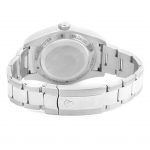Today, we will explore how a vintage watch differs from an antique watch, shedding light on these terms and providing clarity for watch collectors and enthusiasts.
“Vintage” typically refers to items at least 20 to 30 years old but not more than 100 years old. Vintage watches, therefore, encompass timepieces from the mid-20th century until now. These watches often embody a specific era’s design aesthetics, craftsmanship, and technology. Vintage watches are highly sought for their unique styles, historical significance, and collectability. They showcase the evolution of watchmaking techniques, ranging from simple, time-only fake watches to more complex chronographs or complications.
Characteristics of Vintage Watches: 
1.Timeframe: Vintage watches generally fall within the 20 to 100-year age range.
2.Design and Style: Vintage watches reflect the design trends of the era in which they were produced. They may feature specific dial designs, case shapes, and materials that were popular during that time.
3.Mechanical Movements: Vintage watches often utilize mechanical movements, such as hand-wound or automatic, rather than modern quartz movements.
4.Rarity and Collectability: Certain vintage watches become rare and highly collectible due to limited production numbers, unique features, or historical significance.
5.Restorations and Modifications: Vintage watches may have undergone some restorations or repairs over time to ensure their functionality and preserve their value.
Antique Watches: On the other hand, “antique” refers to items that are over 100 years old. Antique watches embody a significant part of horological history, showcasing craftsmanship and design from bygone eras. These watches are treasured for their rarity, historical value, and the stories they carry. Antique watches can vary in style, including pocket watches, early wristwatches, or even rare complications from the 18th and 19th centuries.
Characteristics of Antique Watches:
1.Age: Antique watches are typically over 100 years old, showcasing craftsmanship and design from earlier eras.
2.Historical Significance: Antique watches often carry historical importance, representing specific periods in watchmaking history or significant advancements in technology.
3.Rarity and Condition: Due to their age, antique watches are often scarce and may be found in varying conditions, ranging from well-preserved to requiring restoration.
4.Traditional Movements: Antique replica watches may feature traditional mechanical movements, such as manual winding or early automatic mechanisms.
5.Collectability and Investment Value: Highly sought after by collectors, antique watches can command significant value due to their rarity, historical importance, and desirability.
Understanding the distinction between vintage and antique watches is crucial for watch enthusiasts and collectors. Whether you’re drawn to the vintage styles of mid-20th century timepieces or the historical allure of antique pocket watches, exploring the world of vintage and antique watches can be a fascinating journey into horological heritage.
How a Vintage Watch Differs From an Antique Watch?
{ Comments are closed }